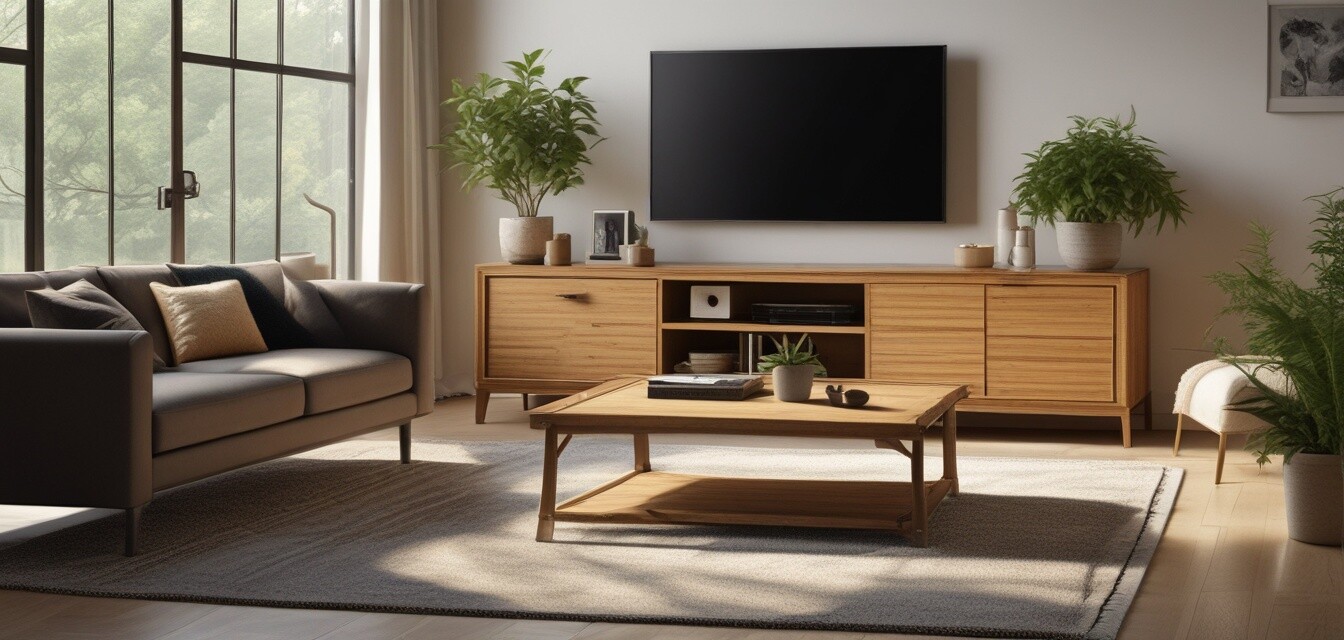
Understanding Different Types of TV Stand Materials
When it comes to enhancing your home cinema experience, choosing the right TV stand is crucial. Not only does it need to fit your aesthetic preferences, but it should also align with sustainable living principles. This guide delves into various materials used in TV stands, with a particular focus on eco-friendly options that are both stylish and responsible.
- Various materials contribute to the durability and aesthetics of TV stands, such as wood, metal, and glass.
- Sustainable materials like bamboo and reclaimed wood are excellent eco-friendly choices.
- Understanding the pros and cons of each material can help you make an informed purchasing decision.
Why Material Matters in TV Stands
The material of your TV stand plays a pivotal role in its longevity, aesthetics, and environmental impact. Different materials bring unique qualities to the table. Here, we will explore the most common materials used in TV stands:
1. Wood
Wooden TV stands are the most traditional and popular choice. They offer a classic feel and sturdy structure.
- Types of wood: Solid wood, plywood, particle board.
- Eco-friendly option: Bamboo and reclaimed wood.
Benefits of wood:
- Timeless and versatile.
- Natural insulation properties.
- Can be refinished for a fresh look.
Drawbacks of wood:
- Can be prone to scratches.
- Requires regular maintenance to prevent warping.
2. Metal
Metal TV stands are known for their modern appearance and durability. They are often combined with other materials for added style.
- Common metals used: Steel and aluminum.
- Eco-friendly option: Recycled metal.
Benefits of metal:
- Highly durable and resistant to damage.
- Offers a sleek and contemporary look.
Drawbacks of metal:
- Can be heavy and difficult to move.
- May require special cleaning materials to prevent rusting.
3. Glass
Glass TV stands can create a chic, open look in your space. They often complement other materials like metal and wood.
- Types of glass: Tempered glass is generally preferred for its safety.
- Eco-friendly option: Recycled glass.
Benefits of glass:
- Easy to clean and maintain.
- Conveys a sophisticated aesthetic.
Drawbacks of glass:
- Can be fragile and prone to breaking.
- Requires careful handling to avoid injuries.
Comparison of TV Stand Materials
| Material | Benefits | Drawbacks | Eco-friendly Option |
|---|---|---|---|
| Wood | Timeless, versatile, natural insulation | Prone to scratches, requires maintenance | Bamboo, reclaimed wood |
| Metal | Durable, modern | Heavy, may rust | Recycled metal |
| Glass | Easy to clean, sophisticated look | Fragile, requires careful handling | Recycled glass |
Choosing the Right Material for Your Needs
Your choice of material should not only be based on style and aesthetics but also on your practical needs. Here are a few tips:
- Think about weight: Ensure the material can support your TV size and weight.
- Consider the room's style: Opt for materials that complement existing furniture.
- Check the environmental impact: Look for materials with sustainable certifications.
Where to Buy Sustainable TV Stands
Fortunately, many furniture retailers now offer sustainable options. For best selections, check out our guides on different types of TV stands, including corner TV stands, entertainment consoles, and floating TV stands. These resources can help you align your television setup with your values of sustainability while enhancing your living space.
Pros
- Wide variety of materials to suit any interior style.
- Eco-friendly options are increasingly available.
- Durability varies, allowing for choices based on lifestyle needs.
Cons
- Some materials require ongoing maintenance and care.
- Price can vary significantly depending on material choice.
- Heavy materials may be challenging to relocate.
Conclusion
Selecting the right material for your TV stand is a vital step towards creating a beautiful and functional home cinema. By choosing eco-friendly materials, you not only contribute to a sustainable future but also create a living space that reflects your values. Take time to explore the different options available and remember to visit our buying guides to make the most informed choice possible.